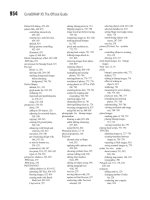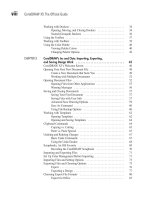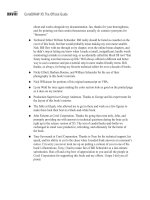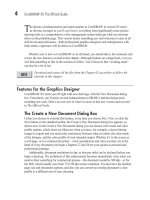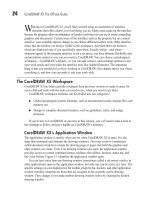CorelDRAW X5 The Official Guide part 33 doc
Bạn đang xem bản rút gọn của tài liệu. Xem và tải ngay bản đầy đủ của tài liệu tại đây (175.98 KB, 10 trang )
handles are also of equal distance from the node. You’ll immediately appreciate the effect
of a symmetrical node; when you drag one control point away from a node, the opposing
control handle moves an equal distance from the node in exactly the opposite direction. The
artistic effect is that the two joined path segments take on an almost circular appearance,
which is very useful for technical illustration work.
Drawing with the Bézier and Pen Tools
Both of these tools are used to create compound paths (segments connected by a common
node) by combining a series of clicks or click-drags, but each is used in slightly different
ways for different results. Using either of these tools, single-clicks define new node
positions joined by straight segments. Curve segments are created by clicking to define the
node position, and then dragging to define the curve shape. Click-dragging in succession
creates a continuous curved path shaped by multiple nodes and off-the-curve control
handles. While using the Bézier tool, each click-drag defines and completes the curve
segment. A little differently, while using the Pen tool, the cursor remains active, and a
preview of the next curve segment appears, so you can define both the curve shape and the
next node point. Double-clicking ends the series of path segments.
When drawing with the Bézier tool, holding
CTRL as you click to create new nodes
constrains their position to align vertically, horizontally, or within constrained
angles relative to the last created node position. Holding
CTRL while dragging
curve handles constrains their angles to 15-degree increments relative to the last
node created.
Let’s try out a new drawing method.
Drawing Curves and Straight Line Segments
1. Choose either the Bézier tool or the Pen tool, and use a single click to define the first
node position of your path. Click again to define a second point somewhere else on
your page. The two nodes are now joined by a straight line.
2. Using the click-drag mouse technique, click to define your next node position, but
continue dragging in any direction. As you drag, the second and third nodes are
joined by a curved line.
3. If you chose the Bézier tool, you’ll notice that two control handles appear joined by
a dotted line. The point you are dragging is the control point that steers the control
handle. The farther you drag the control point from the node, the larger the arc of the
curve becomes. Release the mouse button and notice that the control handles remain
in view, and your path is complete unless you’d like to move a node or refine the
position of its control points some more.
284 CorelDRAW X5 The Official Guide
4. If you chose the Pen tool, you’ll notice that a preview of your next curve appears
as you move your cursor, which remains active until the next node is defined. To
specify a node as the last in the path, double-click to define the current node as the
last point.
5. Using either tool, click your cursor directly on the first node you defined. This
action closes the path and automatically joins the first and last nodes.
Editing Bézier Paths
All lines are controlled by properties of the nodes they include, which are edited using the
Shape tool
(F10). You’ll find this tool, shown next, grouped with the Smudge Brush,
Roughen Brush, and Free Transform tools.
Using the Shape tool, you can change node positions and curve shapes by click-dragging
the nodes, their control points, and by directly click-dragging on a path segment. While
using the Shape tool, icons appear on the property bar when one or more nodes are selected;
you can select several nodes to change by marquee-dragging them or by
SHIFT-clicking a
few. These icons are used to set node attributes to Cusp, Smooth, and Symmetrical; to join
node and break nodes to create individual path segments; and to create straight lines from
curves (and vice versa) when you’ve selected a segment or a node connecting segments. The
bevy of additional functions on the property bar provides exceptional control and flexibility
in your design work. In short, get to know the functions for the Shape tool! The options are
called out in Figure 10-11.
Each of these buttons changes the selected nodes, lines, and curves in specific ways. The
following is a description of what the icons do and what they’re called:
●
Shape Tool Selection Mode New to CorelDRAW X5, this mode can be used to
marquee-select nodes the way users always have, by click-dragging a rectangular
shape around the nodes you want to select, or by using Freehand style, which
produces a lasso-like marquee you can use to be exacting about which nodes in a
group you want to edit.
CHAPTER 10: Drawing and Editing Objects 285
10
Shape tool
●
Add/Delete Nodes These buttons give you the power to add new nodes to a curve
or to delete selected nodes after you’ve drawn a path, using the Shape tool and
clicking at specific points on a path. To add a node, click any point on a line to
highlight the new position, and then click the Add Node button. You can also add a
new node to a line by clicking one or more nodes, and then clicking the Add Node
button to add a node midway between the selected node and the next node on the
path. Pressing the plus (
+) key on your numeric keypad achieves the same thing, and
you might find this a quicker method. To delete a node, click to select it with the
Shape tool, and click the Delete Node button. You can also marquee-select (drag
diagonally with the Shape tool to create a rectangle surrounding the nodes) and then
delete all the selected nodes in one fell swoop. Pressing the minus (
–) key on your
numeric keypad or your
DELETE key also deletes selected nodes.
●
Join Two Nodes/Break Curve When two unconnected nodes on an open path are
selected, for example, when the start point is close to the end point, clicking the Join
Two Nodes button connects them to create an unbroken path. On single paths, only
the unjoined beginning and ending nodes may be joined. On compound paths (paths
that aren’t necessarily close to one another, but that have been joined using the Arrange |
Combine command), the beginning and ending nodes selected on two existing—but
separate—paths can also be joined. While a single node is selected or while a specific
point on a segment is clicked, clicking the Break Curve button results in two nodes
becoming unjoined, in turn breaking a closed path into an open path.
286 CorelDRAW X5 The Official Guide
FIGURE 10-11 The property bar offers comprehensive control over path and node properties.
Select All Nodes
Add Nodes
Delete Selected
Node(s)
Join Two
Nodes
Break Curve
To Line
To Curve
To Cusp
To Smooth
To Symmetrical
Reverse
Direction
Extend Curve
to Close
Extract
Subpath
Close
Curve
Stretch or
Scale Nodes
Rotate or
Skew Nodes
Align
Nodes
Reflect Nodes
Horizontally
Reduce Nodes
(Smoothing)
Reflect Nodes
Vertically
Elastic
Mode
Shape Tool
Selection Mode
Unjoined paths are not the same as separate objects. Two paths, for example, can
be located nowhere near each other on a page and yet still be part of a single path.
If you want to break a path into its component subpaths, you first select the nodes
using a marquee-selection technique with the Shape tool, click the Break Curve
button, and then choose Arrange | Break Curve Apart. Pressing
CTRL+K is the
shortcut, and it’s one of a handful of essential CorelDRAW shortcuts you’ll want
to commit to memory.
●
Convert Line to Curve/Convert Curve to Line These two buttons are used to
toggle the state of a selected straight line to a curve state, and vice versa. A single
click with the Shape tool selects a line or curve indicated by a round black marker
on the line. When curves are converted to lines, the path they follow takes on a
shortcut (as in “the shortest distance between two points”); when converting a
straight line to a curve, the path remains the shape, but control handles appear
directly on the “line,” and the quickest way to make the control points visible is to
drag on the line to force it into a curve shape. When a curve is selected, you can also
adjust the shape of the curve using a click-drag action at any point on the curve and
dragging to reposition the path followed by the curve.
●
Extend Curve to Close For this command to be available, you must have both the
beginning and ending nodes of an open path selected (marquee-select the points, or
SHIFT-click to select them both). Under these conditions, clicking the Extend Curve
To Close button joins the two nodes by adding a straight line between them and
closes the path.
●
Close Curve While an open path is selected, clicking this button joins the
beginning and end nodes to form a closed path by adding a new straight line
between the two nodes; it’s a similar command to Extend Curve To Close, but
depending on the closeness of the start to the end path nodes, you might not even see
a visible straight line connection. You can also join the end points of a selected curve
by using the Close Curve option in the Object Properties docker opened by pressing
ALT+ENTER; then click the Curve tab to find the Close Curve check box.
●
Reverse Direction While a curve path on a line is selected, clicking this button
has the effect of changing the direction of the path. By doing this, the start point of
the path becomes the end point (and vice versa). The results of using this command
button are most noticeable when the start or end of the line or path has been applied
with an arrowhead, meaning the arrowhead is applied to the opposite end of the line
or path. You may also notice subtle changes in the appearance of line styles applied
to a path after using this command button.
CHAPTER 10: Drawing and Editing Objects 287
10
In addition to making arrowheads point in the right direction, Reverse Direction is
also a handy way to enforce PostScript conventions when you print to a PostScript
printer. Adobe Systems’ PostScript language is a page description language that has
very fixed and definite rules about the direction of paths in a compound shape, such
as the letter o. If your compound path o appears to be filled and not hollow, it’s not
“speaking” PostScript language. You click the subpath of the compound path,
reverse the path direction using this button, and the o will then print properly.
●
Extract Subpath This option becomes available only when a compound path is
selected by clicking one of its nodes with the Shape tool. After you click the Extract
Subpath button, the selected path is separated from the compound path, converting it
to a separate path. Using this command on a compound path composed of only two
different paths is essentially the same as using the Break Apart command. It’s more
useful when you need to extract a specific path from a compound path made up of
three or more paths.
●
Stretch or Scale Nodes This is a very powerful CorelDRAW feature not available
in competing applications. When at least two nodes on a path are selected, clicking
the Stretch Or Scale Nodes button allows the transformation between nodes using
their relative distance from each other vertically, horizontally, or from center. Eight
selection handles become available, just as with object selection using the Pick tool,
and you can use a click-drag action from any corner or side selection handle toward
or away from the center of the node selection. Holding
SHIFT constrains the stretch
or scale operation from the center of the selection.
●
Rotate or Skew Nodes Similar to Stretch Or Scale Nodes, when at least two
nodes on a path are selected, clicking the Rotate Or Skew Nodes button lets you
rotate or skew the selected nodes; this is a great feature for refining a shape just a
little, and also for creating more dramatic appearance changes (see the following
illustration). Eight selection handles appear, and you can click-drag from any corner
selection handle to rotate the nodes in a circular direction either clockwise or
counterclockwise. Dragging from any side handle enables you to skew the node
selection either vertically or horizontally.
288 CorelDRAW X5 The Official Guide
●
Align Nodes When two or more nodes are selected, clicking this button opens the
Align Nodes dialog, where you choose among the Align Vertical or Align Horizontal
options that automatically align your node selection accordingly. In addition to these
options, while only the beginning and ending nodes of an open path are selected,
you can also choose to align control points. This has the effect of moving the two
end points of the line to overlap each other precisely. This is a wonderful command
for quickly sketching a zigzag (perhaps for an illustration of a saw blade), and then
in one step, aligning the nodes to create a precise illustration.
●
Reflect Nodes Horizontally/Vertically These two buttons become available when
two or more nodes are selected. You use these options to move nodes by using nudge
keys (the
UP ARROW, DOWN ARROW, LEFT ARROW, and RIGHT ARROW keys on
your keyboard) or using click-drag actions in opposite directions.
To quickly access the same eligible Shape tool node and curve commands available
using buttons in the property bar, right-click the nodes or segments of a path, and
choose commands from the pop-up menu.
●
Elastic Mode With this command, you move selected nodes according to their
relative distance from each other; the effect is like experimenting with a rubber
band. For example, while a collection of nodes is selected, dragging one of the nodes
causes the others to be dragged a shorter distance in relation to the node that is being
dragged. While Elastic mode is off, all the selected nodes are moved equal distances.
Try this option to add a more organic and natural feeling to a drawing you might feel
looks a little too studied and stiff; it adds expression to a path.
●
Reduce Nodes When you use this command, CorelDRAW evaluates the overall
shape based on the nodes you’ve selected, deletes nodes that deviate from a
predictable course along the path, and then repositions the remaining nodes—the
effect is to smooth the curve. For past CorelDRAW users, this was called the Curve
Smoothness slider. To use this feature, select the nodes controlling the segments you
want to smooth, and drag the Reduce Nodes slider control position toward 100. As
you drag the slider, the shape of the curves becomes smoothed, and you’ll notice that
superfluous nodes disappear from the curve. This option is useful for smoothing
lines drawn using the Freehand tool with either the mouse or a digitizing tablet
stylus.
●
Select All Nodes This button selects all the nodes in a path (or compound path)
using one click. It’s a great feature for users who aren’t expert with the marquee-
selection dragging technique yet. You may also select all the nodes in a path with
the Shape tool by holding
CTRL+SHIFT and clicking any node on the path.
CHAPTER 10: Drawing and Editing Objects 289
10
To quickly switch from Rectangular to Freehand node-selecting mode, hold ALT.Any
nodes located within the area you lasso are selected.
Are you ready to test-drive the Shape tool? Follow along here.
Editing Paths with the Shape Tool
1. Choose the Ellipse tool (F7) and create an ellipse of any size. Convert the ellipse
shape to curves (
CTRL+Q) to create a closed path with four nodes joined by four
curved lines.
2. Choose the Shape tool (F10). Notice that the property bar now features all the line
and node command buttons. Click the Select All Nodes button to select all nodes on
the path.
3. With the nodes still selected, click the Add Node button (or press the + key on your
numeric keypad). Notice that four new nodes are added midpoint between the four
original nodes.
4. Click any of the segments once, and click the Convert Curve To Line button. The
curve is now a straight line, and the curve handles have disappeared.
5. Click a node on one of the other existing curves, drag either of the curve handles in
any direction, and notice how they change the shape of the path.
6. Using a click-drag action, click near the middle of the curve segment and drag in any
direction. As you drag, the curve handle positions at both ends move, and the shape
of the curve is changed accordingly.
7. Click any node on the path to select it, and first click the Cusp Node button, and then
click the Smooth Node button. Drag the curve handle of this node in any direction.
Notice that the curve handle may be dragged only in a single direction. Click the
Cusp Node button, and then perform the same action. Notice that the lines on either
side of the node can be curved in any direction independently of each other.
8. With this node still selected, click the Break Curve button to split the path at this
point. Although it may not be obvious, two nodes now exist where the original node
used to be. Drag either of these nodes in any direction to separate their positions.
The nodes are now control points because they break the path to form beginning and
end points.
290 CorelDRAW X5 The Official Guide
9. Select one of these nodes, hold SHIFT while clicking the other, and click the Extend
Curve To Close button. Notice the curve is now closed again, while the two nodes
have been joined by a straight line.
10. Undo your last action (CTRL+Z) to unjoin the nodes and, while they remain selected,
click the Align Nodes button to open the Align Nodes dialog. If they aren’t already
selected, click to select all three options (Align Horizontal, Vertical, and Control
Points) in the dialog, and click OK to align the points. Notice that they are
positioned to overlap precisely. Click to select both nodes, and click the Join Two
Nodes button in the property bar. Your path is now closed, and the nodes are joined.
11. Hold SHIFT and click to select two or more nodes on your path. With your nodes
selected, click the Stretch Or Scale Nodes button, and notice that eight selection
handles appear around your node selection. Hold the
SHIFT key (to constrain from
center), and drag one of the corner handles toward or away from the center of the
selection. All node positions are scaled relative to each other’s position, and the lines
joining the unselected nodes also change shape.
12. With the nodes still selected, click the Rotate Or Skew Nodes button in the property
bar. Notice that eight rotate and skew handles appear around your selection. Drag
any of the corner rotation handles either clockwise or counterclockwise to rotate the
nodes. Notice that they are rotated relative to their current position, and the lines
joining the unselected nodes also change shape.
The preceding tutorial is only a sampling of what can be accomplished when editing
nodes using the Shape tool. You’ll want to invest some quality time practicing your editing
skills using all the available node-shaping command buttons, because the payoff is better
artwork, artwork that’s closer to what you have in your head, and in the long run, you’ll save
time creating wonderful pieces.
To set the drawing behavior of the Freehand and/or Bézier tools, double-click either
of their tool buttons in the toolbox to open the Options dialog to the Freehand/
Bézier tool page. Options are discussed in the next section.
Controlling Freehand and Bézier Tool Behavior
The settings to control how Freehand and Bézier tools create the curves and lines you draw
are set using a series of options in the Freehand/Bézier Tool pane of the Options dialog,
shown next. To access these options, choose Tools | Options (
CTRL+J), expand the tree
subdirectory under Toolbox, and click Freehand/Bézier tool. The quick way to get to this
CHAPTER 10: Drawing and Editing Objects 291
10
box is to double-click the Freehand or Bézier tool buttons after choosing them from the
Curve tools group.
Here’s how the options work:
●
Freehand Smoothing The Freehand Smoothing option enables you to set the
default value of the Freehand Smoothing option in the property bar while drawing
with the Freehand tool. Smoothing may be set based on percent within a range
between 0 (minimum smoothing) and 100 (maximum smoothing). This option is
largely redundant with the Freehand Smoothing option available in the property bar
when a curve and the Shape tool are selected.
●
Corner Threshold This option is for setting the default value for corner nodes
when drawing with the Freehand or Bézier tool. Lower values cause nodes to be
more likely set to cusp nodes, and higher values cause them to more likely be
smooth nodes. The range may be set between 1 and 10; the default is 5.
●
Straight Line Threshold This option pertains to how the shapes of lines or curves
are created when drawing with the Freehand tool. Lower values cause nodes to be
more likely set to straight lines, while higher values cause them more frequently to
be curved. The range may be set between 1 and 10; the default is 5.
●
Auto-Join This option sets the behavior of the Freehand or Bézier tool while
drawing closed-path objects. This value represents the distance in pixels your cursor
must be when clicking near the first node of a newly created path to close the path
automatically. Auto-Join can be set anywhere within a range between 1 and 10
pixels; the default is 5 and is probably the best overall choice for large screen
resolutions commonly run today.
292 CorelDRAW X5 The Official Guide
Working with Compound Paths
Compound paths have at least two separate paths (either open or closed) composing a single
shape. To examine an example of a compound path, use these steps:
1. Choose the Text tool (F8), click once to define a text insertion point, and then type an
uppercase Q character. You can assign the character any typeface you like; the more
ornamental the character, the more obvious the compound path soon will be. This
character shape shown in Figure 10-12 has two paths that are combined: one
represents the “positive” space, and one represents the “negative” space shape.
2. While the text object is selected, convert it to curves (CTRL+Q). The status bar now
indicates the object is a Curve on Layer 1.
3. Change your view to Wireframe; choose View | Wireframe.
4. Press CTRL+K (Arrange | Break Curve Apart). With the Pick tool, click an empty
area of the page, and then click one of the objects and drag it to move it; clearly the
two paths are now separate. As shown in Figure 10-13, you have just converted a
compound path featuring two subpaths into two individual objects. Go back to View
and restore your view quality to Enhanced.
Combining Objects
When separate objects are combined, they behave as a single object. When two or more
closed paths are combined, they form positive and negative spaces within the object.
Applying a fill to this type of object causes the positive shapes to be filled, and the negative
shapes remain clear, as shown in Figure 10-14. You can use the Combine command by
choosing Arrange | Combine, or by using the
CTRL+L shortcut. You can also click the
Combine button in the property bar, or choose Combine from the pop-up menu.
CHAPTER 10: Drawing and Editing Objects 293
10
FIGURE 10-12 In vector artwork, “holes” in objects are achieved through compound paths,
paths that are combined to create a single object.
Original
Outer path creates
positive space.
Inner path creates
negative space.
